Section 1, Section
2, Section 3, Section
4, Section 5, Section 6, Section
7, Section 8
From: Keri Hulme
Date:
Thursday, 24 June 2004 4:07 a.m.
Subject: show me a wheel. show me
iron, show me pottery, show me leatherworking,
in fact, show me *one*
thing that cant be honestly traced to my Eastern Polynesian ancestors (o, I'm
quite happy if something can be traced to my Western Melanesian ancestors.)
Just for a starter, only 70% OF MAORI HAVE A ROCKER JAW. It is a very high percentage
for a human group, but NOT having a rocker jaw is not a diagnostic for a jawbone
coming from a NON-Maori.Nor is being urukehu. Go have a look at people - just
for instance - in the Bismarcks. Many blond kids there(and they dont have Euro
mother/father/s.) That's too far from here? Nope, they followed the cuckoo too-
There
is NOTHING - your stone works are a joke - real Celts built substantial rings
and dolmens and chambers, not pathetic wee sighting heaps or rolled over tiny
stones - EVER discovered here that says anyone except my Eastern Polynesian (possibly
Western Melanesian at some stage) ancestors were here before my Celtic ancestors.
I find your paranoia (re supposed Government cover-ups) and your racism sad. O,
and nasty, offensive, vicious, and due to get its own comeback. Bye bye. Ka mutu
tena.
Hi Keri,
The stone work on the New Zealand landscape
is far from, "wee sighting pits or rolled over tiny stones",
as you put it. Many of the individual, purpose placed obelisks are in the estimated
range of ten or twelve tons...or a lot more.

Picture of a partial survey done on a high hill obelisk site east of Auckland
City. The huge, purpose place obelisks of this elevated site are composed of smoothed,
water-worn Greywacke. The components have been acquired from either the seashore
or a river waterway and hauled, at great labour, to the distant, high hill location.
There is only this singular arrangement of huge stones in the immediate region
and the general terrain, all around for a considerable distance (possibly several
miles), is devoid of any natural stone. The obelisk observatory/ temple, slightly
down to the east on the hill summit, orientates onto the solar rise positions
to the east, where a distant range acts as an "outer marker" for summer
to winter solstice fixes, with the equinox centrally located due east. Although
large trees now obscure much of the eastward view, sufficient can be seen through
the hillside vegetation to determine how the site, in a general sense, works and
why it was erected at that exact position. Sites like this are all over New Zealand
and the greater Pacific region. We know of two more such sites in that east-of-Auckland,
general vicinity, requiring surveying assessments. These are sites attributable
to the people that your Maori oral traditions refer to as the "Stonebuilders"
and describe as "kiri puwhero and urukehu"...reddish, light complexion
in skin colour and with red, blond or brown hair and several varied hues of eye
colour.
Samples of their platted hair used to be on display
at Auckland War Memorial Museum and were commented about by Sir Peter Buck, who
acknowledged the existence of his "white" pre-Maori ancestors.
Around
Anzac day about 7-years ago, an ex-military friend of mine was visiting Mt Ngongotaha
in Rotorua. He had a little interval down by the lake and met a very interesting
old Maori ex-veteran who was wearing the distinctive Anzac poppy. The conversation
with the old local elder moved through stages of discussing lake weed, to the
recent Maori take-over of Mokoia Island, to the long-term history of the region.
The old gentleman, Mr. Clark, then made an historical account about the former
people with 'golden shining hair and ginger hair' who had lived throughout
the region before Maori. He spoke of them having settlements on Mokoia Island,
at the Green & Blue Lakes and on the mountain. He mentioned how his Arawa
ancestors had warred with them and driven them out. He thought they might have
gone to Wanganui. The old gentleman told of areas around the Rotorua Lakes where
Maori are still reluctant to land their boats, due to the remnant stonework of
the Patu-pai-arehe still in existence there. He said that one of the large settlements
of these ancient people was at Artiamuri.
It's interesting
that on Mokoia Island there is a stone statue, which is a South American potato
god. There are also incised carvings in stone cliff faces there, including one
of the Mediterranean/ South American Hei-Tikis.
The incised
stonework of the ancient stonebuilders, very often incorporating the spiral pattern
designs as found in places like New Grange, Ireland (circa 3000 BC), can be found
around the shores of Lake Okatina, Rotorua, as well as many other areas like Raglan
or Castle Hill in the South Island.
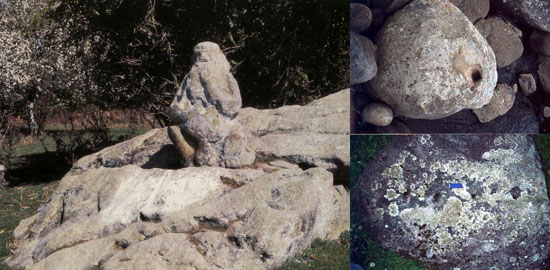
The
potato-god statue at Mokoia Island in the centre of Lake Rotorua. This was associated
with the "uru-kehu" and "kiri-puwhero" pre-Maori people, as
described in Maori oral traditions. Potato god statuettes, fashioned in stone,
were found throughout the Auckland Isthmus and are on display at Auckland War
Memorial Museum.
The images to the right, in the above
picture, are cup stones found at Koru PA in Taranaki (the stone PA), which also
has a sophisticated standing stone circle (stones now lying on their sides) adjacent.
Cup stones are a thousands-of-years-old cultural idiosyncrasy that's found from
Russia-through Estonia to Ireland. To this very day, Irish farmers will place
some grain or milk into ancient cup stones, found on their farms, as an offering
to the fairies. This is done as the growing season commences to ensure good harvests,
fortune and success.
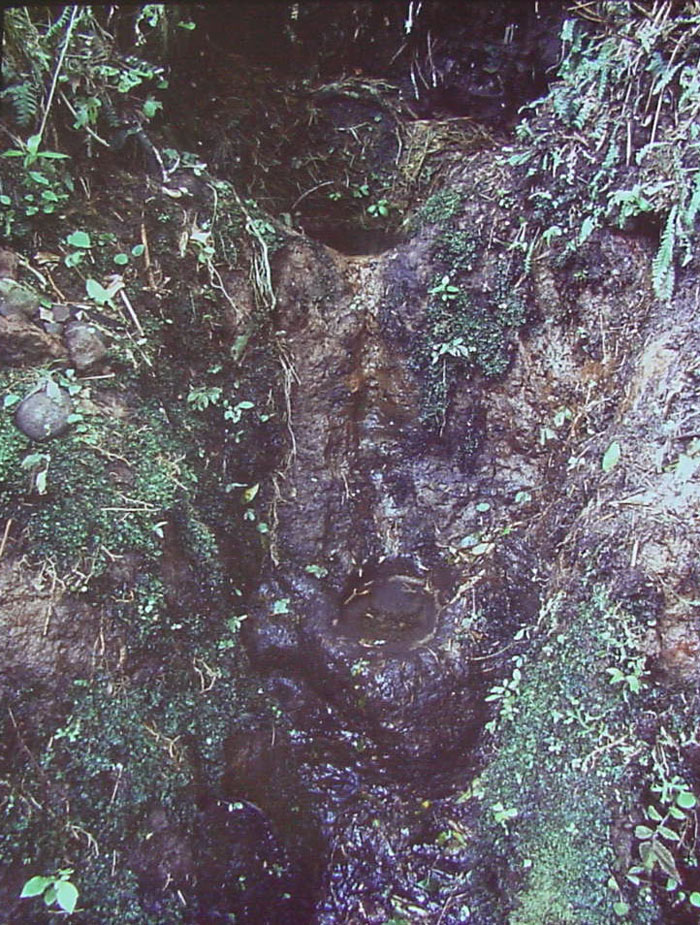
The
cut bowls shown in this picture are bullaun bowls, carved out of sold rock and
found in Taranaki, New Zealand. Typical bullaun bowls, like these, were used anciently
all over Continental Europe and Britain and are associated with the "wishing
well" traditions of that region. When the Roman Christian Church found they
could not eradicate "bullaun" usage amongst the "forcibly christianised"
populations of Europe, the church adopted or absorbed use of the bowls as baptismal
fonts. Many Europeans seeking convalescence from sickness for themselves or loved
ones, to this day, make pilgrimages to the bullauns at the holy wells to say prayers
and do ceremonial washing. The bowls are associated with the "blessing and
cursing altars of Europe and especially Ireland. One old Irish witch is said to
have caused invading English ships to come to grief and sink, due to her cursing
incantations over a bullaun. New Zealanders should seek out these laboriously
cut stone bowls (in boulders or rock outcrops) at trickle waterfalls around the
country. (The above photo taken by Taranaki archaological researcher, Hip Fenton).
These
ancient bullauns are now being found and recognised for what they truly are in
New Zealand, along with cup stones. These are some of the many extant cultural
idiosyncrasies which display an "all round" link to ancient Europe and
the Mediterranean... from whence many pre-Maori inhabitants of New Zealand came.

The
left hand picture shows huge remnant boulders of the main ancient surveying position
for the many interrelating ground markers of the Waitapu Valley in Northland.
This former pillar or compact surveying circle position sits on a now forested
ridge. Typical British or Rennes Le Chateau type geometric relationships, occurring,
over several square miles between large, purpose placed markers of the Waitapu
Valley region, indicated that the main surveying position had to be exactly there.
I calculated the exact co-ordinates in AutoCAD on the computer, then let a GPS
unit lead me through low bush to the precise spot, which I had never visited before.
The purpose built marker was exactly where it had to be and there was nothing
remotely like it, nor any other substantial stonework, anywhere along the rest
of the elongated ridge.
The middle picture shows another
giant obelisk, which sits in a precise surveying relationship to the ridge pillar,
a mile away to the north. This obelisk is smaller than the Greywacke ones east
of Auckland, but it still approaches seven or eight tons or more.
The
right hand picture shows a "hubstone" of one of several stone circles
in the Waitapu Valley region. Some years ago, farmer, Michael Griffiths, who did
not then know the significance of the stone, decided he'd like it for his home
garden. He took a big Russian front end loader up to the hill summit to get it,
but was unable to lift it. Thankfully, it's stayed put, which allows me to work
out the ancient surveying geometry related to its precise positioning by the Patu-pai-arehe
engineers.
This modern-day archaeological surveying work
is done with tremendous care and there are no "flights of fancy". Overland
positions are logged with GPS and all co-ordinates entered into the computer,
such that distances and angles between the "very obvious" ancient
surveying markers can be precisely determined within the exacting confines of
AutoCAD. Any surveyor can duplicate this positional fixing work and will get the
same amazing geometric relationships occurring over extended distances. Small
area, individual sites are surveyed with a theodolite.

Here
is a simple, but typical solar observatory arrangement to be found all across
New Zealand in locations where the ancient Patu-paiarehe (Stonebuilders) lived.
They erected full "standing stone circles", as well as solitary arrangements
of large, often "sharksfin-shaped", stones like this "double stone"
solar observatory, found in a Maungaturoto farm field. Although this marker arrangement
is still being fully assessed, having only recently been identified, it is very
conveniently placed to work with the eastern horizon of distant hills. The marker
was purpose placed to gauge the rise positions of the sun from Summer solstice
to Winter solstice. The precise spot was, undoubtedly, chosen such that the Summer
solstice rise, or each of the other significant solar events, would occur on pinnacle
peaks or other very recognisable landmarks, giving a precise calendar fix. Mt.
Pukearinga provides the outer marker position for the Winter solstice sunrise.
Mt. Pukekaroro further south will, undoubtedly, be the outer marker for yet another
annual solar, milestone event, observable and calculable from this field observatory.
The very large, heavy stones (several tons in weight) have been hauled to the
location and purpose erected and there is no natural stone occurring on surrounding
hills (dirt hills). An ancient Patu-paiarehe stone ramp leading down to the water's
edge once existed at Maungaturoto, but the stone paving was pillaged for a cattle-yard.
The
carved stone bowl in the right-hand picture is typical of ancient Patu-pai-arehe
"mortar and pestle" sets. This one was found at Pahi on the Kaipara
shore east of Tinepai and near the Arapoa River by an old gentleman who lived
at Batley House. It might also have functioned as a bullaun.

A
huge and laboriously carved, ancient concentric ring stone (bulls-eye design)
sits on its side in the Waipoua Forest of Northland, New Zealand. This is the
location of former "Beehive House" hovel dome villages, walls, altars,
hearths, cupstones and many other expressions of the former Patu-paiarehe stoneworking
culture. The centre picture shows carved ringstone depressions at Achnabreck in
the Argyll region of Strathclyde, Scotland, with some cups carved into the concentric
circle ridges. The Waipoua Forest, New Zealand, ringstone appears to have some
cups in it also. The picture to the right shows another ancient bullaun artefact,
located in Northland, New Zealand.
Because the concentric
ring stone symbol was such an old cultural expression of Great Britain (thousands
of years old), it was adopted as the insignia on WWI and WWII aircraft or amongst
other services within the British military.
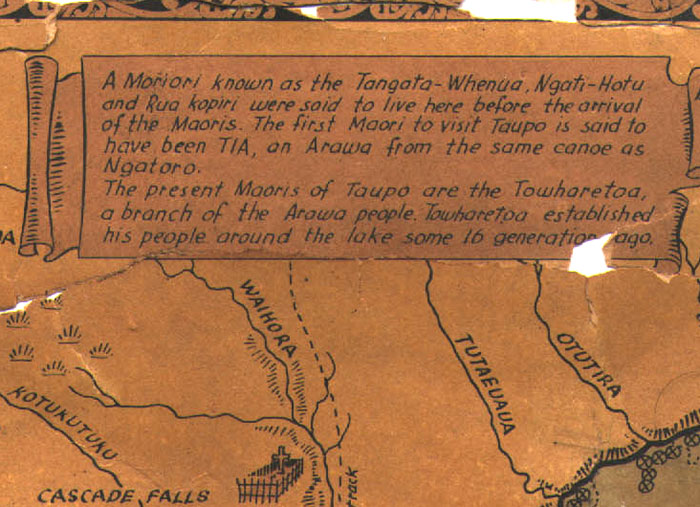
All
the old maps of New Zealand, like this fragmented one of Taupo, invariably made
reference to the pre-Maori people, as did the "pre-grievance industry"
books. Maori elders recounted the stories openly, until recent years, when the
corporate kaumatuas took over. The drafters of these (now) "politically incorrect"
maps or authors of these (now) "unauthorised" books, full of unmentionables,
religiously recorded what the Maori historians had told them. It is well attested
in oral traditions that the Ngati Hotu, referred to on the old Taupo map above,
were a "white" tribe, whose remnant survivors met their final demise
in early colonial times.
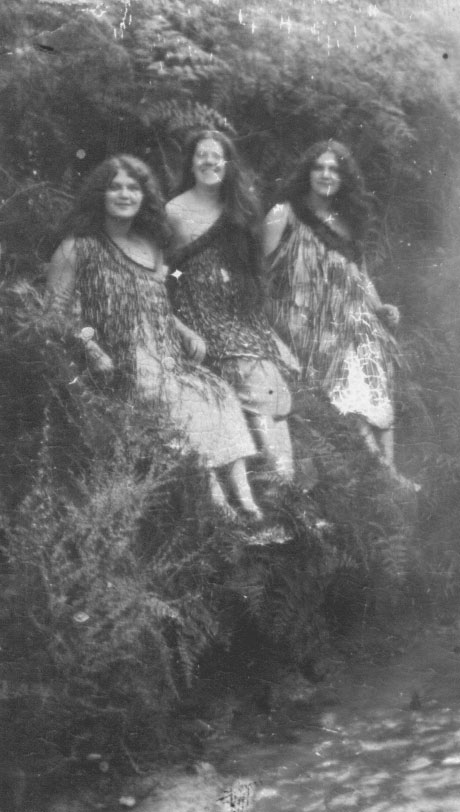
Is
this a picture of Ngati-Hotu women? The above photo comes from a 19th century
postcard about Wairaki in the Taupo District. The twin sisters to each side of
the very European central figure are predominently European themselves, but have
some Maori lineage. The centre figure has her breast partially exposed, which
would have been utterly against the principals of European Victorian women of
the era. All are dressed in Maori attire. In early New Zealand colonial history
there were still large pockets of "white Maori" or what was known as
"waka blonds".
In my collection of "kiwi-ana"
memorabilia I've got the "glue-on-cards" that kids of the 60's used
to get in their Vita Brits cereal boxes to collect and swap. One collection was
devoted to New Zealand history and repeatedly mentions the pre-Maori people. Girl
guides and Brownie groups of the 60's used to use various Patu-pai-arehe names
for brigades within the organisations, etc., etc.
Reverend
Richard Taylor wrote in 1855: 'Besides gods the natives believed in the existence
of other beings, who lived in communities, built pas, and were occupied with similar
pursuits to those of men. These were called Patu-paiarehe. Their chief residences
were on the tops of lofty hills, and they are said to have been the spiritual
occupants of the country prior to Maori, and to retire as they advance. The Wanganui
natives state, that when they first came to reside on the banks of the river,
almost all the chief heights were occupied by the Patu-paiarehe, who gradually
abandoned the river, and that even until a few generations ago, they had their
favourite haunts there. These may be accounts of an aboriginal race mixed with
fable; there are several things to warrant the idea that the Maori were not the
first inhabitants of the land.
The Patu-paiarehe were only seen early in the
morning, and are represented as being white, and clothed in white garments of
the same form and texture of their own; in fact, they may be called the children
of the mist. They are supposed to be of large size, and may be regarded as giants,
although in some respects they resemble our fairies. They are seldom seen alone,
but generally in large numbers; they are loud speakers and delight in playing
the putorino (flute); they are said to nurse their children in their arms, the
same as Europeans and not carry them in the Maori style, on the back or hip. Their
faces are papatea, not tattooed, and in this respect also, they resemble Europeans.
They hold long councils, and sing very loud; they often go and sit in cultivation's,
which are completely filled with them, so as to be frequently mistaken for a war
party; but they never hurt the ground…
The belief in the Patu-paiarehe
is very general; many have affirmed to me that they have repeatedly met with them.
Albinos are said to be their offspring, and they are accused of frequently surprising
women in the bush.' (see Articles from "Te Ika A Maui, NZ and its
Inhabitants", by Rev Richard Taylor, written in 1855; facsimile
reprint in 1974 A.H. & A.W. Reed.
I know where there
are several large Patu-paiarehe earthen amphitheatres (where they spoke or sang
loudly?), obviously for communal assemblies. I've seen these and visited them
frequently and have also heard of several more, including one in the Waipoua Forest.
A pig-hunter that I know stumbled onto one of the large Patu-paiarehe stone forts
(same general style as Koru PA in New Plymouth, Taranaki) with the network of
internal souterain tunnels. It's found way up in the high country of the Matemateaonga
Ranges near Wanganui. I've also been told about the remains of many simple stacked-stone
buildings up there (including a beehive house hovel dome village), which are located
a couple of days walk into the deep bush and inhospitable terrain.
The
wheel: It's quite correct to say that the Celts (circa 1000 BC until the time
of Christ) used the wheel universally. The structures in New Zealand have the
appearance or style of being much older than the Celtic era and I attribute them
to the pre-Celtic people (those groups in Europe who later amalgamated to form
the Celts). It is said that certain Muslim colonies of Africa did not use the
wheel, although it was common practice to do so in their homeland countries. In
this regard, I believe we have to look at several local problems or natural attributes.
- There were no large beasts of burden locally to pull any kind of cart.
- The
country is very long and reasonably narrow, with superb beach highways stretching
for extensive distances. These provided very convenient and "food-abundant"
travel routes.
- There are many estuaries, rivers and navigable streams,
canals and waterways traversing the country, making canoe transportation very
effective and practical.
- The topography over much of New Zealand
is quite hilly and the ancient, vast system of well developed and maintained walking
tracks was the best all-round option, until British colonials introduced the horse.
Metal:
A kaumatua has told me of ancient metal artefacts (bronze) being found in
New Zealand. It's unlikely that any ferrous metal from the earlier era could have
survived in our salt-laden sea air. If anything metallic was now found it, undoubtedly,
would be attributed to the colonials.
Leatherwear: Apart from the
remnants of leather boots reportedly seen on Spanish shipwreck skeletons buried
in the sand dunes of the Poutu Peninsula (and sometimes uncovered when the dunes
move), there's little hope of finding it in a country that had no large land-animals,
other than dogs. Oral history descriptions of the Patu-pai-arehe indicates that
they wove linen garments derived from flax. Their fishing nets seem to have been
made of strong, woven flax fibre cords also.
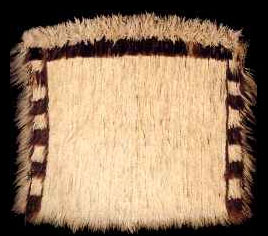
Dogskin
leather. The dog was, undoubtedly, introduced to New Zealand along with the Polynesian
Rat, which has been in New Zealand for at least two milleniums or more. The wide
distribution of these species throughout the Pacific is attributed to the Lapita
People of circa 1900 BC to about 0 BC.
Cover ups: A colleague
wrote away under the Official Information Act (Freedom of Information)
to ask how many archaeological embargos are presently in place. The answer we
received back from MP John Carter stipulated that there are 105. He wrote
in part:
'Filekeepers may create sensitive files...if this is requested
by the site recorder and there is a valid reason to do so. When considering this
classification the filekeeper shall have regard to:... Local Maori concerns about
the protection of the site.... The category should, however, be used sparingly.
All information held in the NZAA central File is official information for the
purposes of the legislation. Any decision about release of sensitive information
from its collections would have to balance the various statutory considerations,
including the need to "protect information which is
subject to an obligation of confidence".
My department, which
was established in 1987, is not aware of any information embargoes, apart from
those referred to above on the NZAA Central File that may have been in place prior
to that. It is not a legitimate task for the department to follow through on your
request to use the O.I.A. to obtain information from other sources."
Yours sincerely. Hon. Chris Carter MP'.
Pottery:
AN
OLD NEWSPAPER REFERENCE TO POTTERY SHARDS FOUND AT PORT WAIKATO, NZ.
NZ
Truth, Wednesday September 29, 1965 - page 13.
CAVES
COULD REVEAL SECRET OF TALL MAORIS
By John Wilson
A
Tribe of Aztec type Maoris could be making a desperate bid to stop the opening
of their one-time cave homes - from behind the grave.
The
most recent attempt to open the caves was foiled when a big mud slide almost blocked
off the entrance to one of the caves. But another attempt is soon to be made with
the aid of bulldozers.
The pathetic history of this tribe of tall Maoris is
one of the most heart-rending tales of Maori legend.
Maoris at remote but
beautiful Port Waikato, 70 miles south of Auckland, believe the tribe has tried
in the past to stop the opening-up of its one time home in the cliffs.
Three
times, the locals believe, the dead tribe has thwarted moves to open the forbidding
caves in which they lived - and died.
The Maoris at the little coastal town
have known about the caves for centuries.
First move to open them came 80
years ago.
Well hidden and fairly inaccessible, they have, nevertheless, been
visited by a few determined folk over the years - many of them vandals.
Then,
not long ago two local men decided the caves were too good to go to waste. They
decided to open them up. And that's when the slip occurred.
As if arranged
by some giant constructor, a big slide of mud eased itself downhill almost sealing
off the cave mouth.
Local Maoris believe it was the tapu of the Tall Ones
at work again.
The existence of the Tall Ones has given New Zealand one of
its most macabre and little-known legends.
For this "Lost Tribe"
was virtually eaten to death.
A hard core of historians are convinced the
tribe existed.
Their belief could add strong evidence to the widely-held
belief that the Maoris or some segment of them originated in South America.
Unfortunately, written evidence of the tribe is scant.
Most was destroyed
in one of several disastrous fires which ravaged the old Port Waikato mission
station last century.
A resident there is believed to have compiled a vast
dossier of information on the tribe. Much of this was gathered by word of mouth
from old Maori living in the area at the time.
Other more tangible evidence
was gathered by the man himself on several trips into the then virgin caves.
Among the finds were several pieces of pottery, I've
been told. And as students of Maori history can tell you, the ancient Maori did
not make pottery.
Then there was the appearance of the
Lost Tribe.
They were much taller and thinner than the Maori. And they were
not cannibals.
This, combined with a tribal history of Phinisis, a lung disease,
probably led to their untimely extinction.
For the peaceable, cultured Tall
Tribe were hunted and eaten out of existence by the local Maoris.
The Tall
Tribe, with the markedly Aztec-type features, were believed to have settled originally
in the Waikato before the Maori.
Then gradually, over a period of years, the
Tall Ones were hunted further and further up the Waikato Valley.
They moved
from cave to cave, trying to keep their shrinking tribe away from the Maori cooking
ovens.
But each new hiding place was eventually discovered by the Maori hunters
and the Tall Ones had to move on.
Sadly, their birth rates could not keep
pace with Maoris' appetites.
But something else took its toll on them also.
They were prone to the lung disease, being forced to live almost entirely in dark;
damp caves.
But even so the writing was on the wall for the ever-shrinking
numbers of the Tall Tribe.
It was only a matter of time before the Maoris
found their last retreat and ate them all.
Today, in the hilly
country a few miles down the coast from the little township at the mouth of the
Waikato River, their last homes still exist.
Three of the caves in which they
must have staged their last frantic fight against annihilation have been discovered.
Others may also exist.
Two of the caves are big. Tameana, the most accessible,
has an entrance about 30ft high. It is about 1½ miles deep and once probably
went right through the hills to the sea. A fall of rock, however, has made it
impossible to find out.
The other cave, Hineana, is about half a mile away
and is neither as easy to find nor as big.
This is the cave that local Maoris
steer clear of at night.
The name Hineana was given to the cave
because of a peculiar moaning noise that comes from it on occasions.
The
Maoris believe it comes from the spirits of the Tall Tribe lamenting for their
dead.
Features of the caves are limestone formations and glow-worms.
Hineana has a giant white stalagmite standing alone about a half mile in from
its mouth.
Glow-worms are reportedly as fine as at Waitomo.
Why hasn't
anything been done about opening up the caves before then?
Three
attempts have been made in the last 80 years. All have foundered on the powerful
"tapu" that surrounds them.
Perhaps the idea of the two Waiuku men
to run electric lights into the caves and clean them up is the best thing that
can happen.
But there is one cave that will not be entered for a long time,
if at all.
It is the secret burial cave that is reported to exist near the
two bigger dwelling caves.
It is packed with the dead of the tribe.
Its
entrance has long been sealed; And local Maori, unwilling to incur the wrath of
the dead there, have reinforced the blockage.
They are delightfully vague
about its exact whereabouts too.
In it is probably the only real proof of
the Tall Tribe's existence.
For if they were in fact of Aztec origin they
probably buried their dead with their belongings.
Some may even have been
mummified.
Just now, no-one is too keen to find out.
Rumour of a powerful
curse on the tomb of the Tall Ones keeps the locals - and everyone else - well
at bay.
This week I stood where a bulldozer will soon roar through
dense bush that has seen no inhabitants since the mystery tribe.
The dark,
forbidding mouth of the cave took on an even more sinister appearance as I recalled
the tale of the tribe who made its last stand inside.
Where once remnants
of the pathetic band cowered and were massacred and eaten, families will picnic.
Through the bush where the tribe made its last desperate bid to avoid extinction
visitors will soon click cameras at native pigeons
The only noise there since
the screams of the last massacre victims died away have been the tinkling of tuis
and the chattering of fantails.
They have been the bush's only inhabitants;
the cave's only custodians for centuries.
It's interesting to note
that journalist, John Wilson mentions "mummified remains" in his 1965
article. Australian scientist, George Elliot Smith removed mummies from a cave
a little further down the coast beyond Raglan in 1931 and they ended up in Australia.
We have a strong indication that these mummies, along with many Maori artefacts,
were repatriated to New Zealand in about 1995 from Adelaide Museum. Sadly, they're
still kept under wraps (pun intended) and the public are not privy to any forensic
assessment concerning them. Respected New Zealand archaeologist/ surveyor, P.G.
Hunt mentions the mummies acquired by Smith in a 1950's article devoted to shipwrecks
and "stonework" archaeological remains on that coast.
A few months
ago an evening caller to Ian Wishart's talk-back station mentioned ancient,
very large clay pots that had been uncovered adjacent to the Waikato River.
The individual sounded very well informed and had, apparently seen the artefacts
himself. I could probably go back through my notes and identify the exact date
of the call, which I remember jotting down.
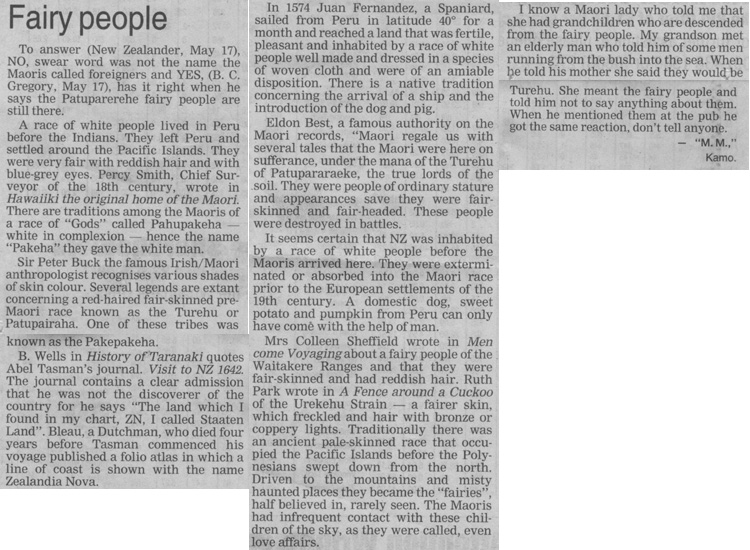
Here's
an article from The Northern Advocate (May 2004) devoted to the Fairy People.
A rare and very old book gives an account of a pre-Tasman
French expedition (led by Sieur de Gonneville) to New Zealand as well, where one
of New Zealand's inhabitants, an individual named Essemoric, returned with the
ship's crew to France and later married into French aristocracy (the De Gonneville
family). The French expedition departed New Zealand on July 3rd, 1504. The inhabitants
of the land found by De Gonneville are, 'represented as
boiling water and cooking food in earthern vessels'. They were also said
to have used the bow and arrow (like the Lapita People).
It's interesting to note that arrow heads made of chert
were found on the Isthmus connecting the Mirimar Peninsula with the mainland in
the vicinity of Wellington. I've been told of another ancient New Zealand
arrowhead collection in the possession of a private individual, who scouts around
a particular old PA to find them. (See Histoire Abrege de la Mer du Sud,
by Abbe de la Borde).
So far, the tally of Roman or Egyptian coins
found in New Zealand stands at about 3. One was found by a Mr. Tasker in Hawkes
Bay (Roman) when boring a hole for a clothesline in a new subdivision; one was
found in Northland (Egyptian) some years ago and another (Roman) was found in
December last year (2003) beside the Taylor River in Marlborough. Last year's
find was a coin dating to 7 BC. See: http://www.smh.com.au/articles/2003/12/26/1072308677554.html?oneclick=true
THE
BISMARCK ISLANDS & LAPITA POTTERY.
You mention the blonde Melanesian
children of the Bismarck Islands, and I admit to having been long intrigued by
the incidence of blonde hair there. Although the early blondness is not universal
and generally recedes in maturity, it is, nonetheless a fascinating genetic phenomena.
I've read a number of explanations for this, including claims that there is an
ancient Caucasoid element present that triggers the "blonde" occurrence.
It's, perhaps, very significant that the Bismarck group is in the belt where Lapita
Pottery is found in the largest quantities, more-so than other regions of Melanesia
or Western Polynesia.
For quite some time I have tried to source a comprehensive
physical anthropological report on the "Lapita People" skeletons,
but there seems to be academic reluctance to broach the subject clearly and concisely.
This evasive attitude has been commented on by several writers. What little anthropological
evidence can be gleaned, shows no real relationship between the Lapita People
and the much later Polynesians and this is, apparently, being reinforced as time
goes on. Typical of this "withholding of evidence" relates to
a very good find in 2002. The following is the first/ last newspaper report we
received on the subject. The only variation in articles is found in the fact that
the first press release said the skeleton was of a person 2 metres high (approaching
6' 7"):
'Mysterious skeletal remains of what appears to be
a 3000-year-old giant have been unearthed on a South Pacific islands, but the
bones' discovery has rattled local archaeologists who say poor treatment of the
remains may have lost vital information.
Little is known about the
highly unusual find, which includes a skull bearing strange holes drilled into
its cheekbones, with authorities keen to keep the controversial
discovery under wraps.
According to sources, the body, found
at Lomaiviti, an island to the north of Suva, predates European exploration of
the Pacific and it is believed the man was originally from the Solomon Islands.
The body was discovered last week by a Solomon Islander from the
University of the South Pacific (USP), alongside examples of Lapita pottery &
artifacts created by a group of Melanesians believed to have been the founders
of modern Polynesia.
Measuring 1.9 metres (the earliest report
of the find said 2 metres), the body is unusually large considering its age
and origin. Pictures of its skull show the holed cheekbones, a feature unseen
in previous discoveries, according to Fiji Museum sources.
The head
of prehistory archaeology at the museum, Sepeti Matararaba, said the discovery
of the body and pottery was "significant"....'
"Patrick
Nunn, the supervisor of the archaeological team analysing the remains at USP would
not comment and said on Sunday "we have decided to
keep our find under wraps". 14 July 2002.
Our forensic scientists
are (in the new, Pacific socio-political climate) denied access to human skeletons
for study. Lisa Matisoo-Smith of the University of Auckland, New Zealand
is obliged to use "Kiore Rat" remains in order to learn something about
ancient Pacific peoples:
'Unable to research genetic variations in ancient
people, she turned to the next best thing - rats. Matisoo-Smith and a colleague,
J.H. Robins, examined the variations in mitochondrial DNA of ancient and modern
samples of a rat species, Rattus exulans, from Bougainville, New Britain and other
Polynesian islands. This species was used as food by the Lapita people in their
outrigger canoes when they settled parts of Oceania roughly 3,000 years ago...
There is much evidence the Lapita people took R. exulans along for food. Unlike
European rats, Matisoo-Smith said, exulans do not swim and they dislike wet conditions.
So it is unlikely that they accidentally reached the islands
through infested ships.
As a food source, the rats don't require much
effort. The Lapita would just have to release them on the islands they settled,
and rats being rats, there would soon be plenty for eating.
That also left
plenty of rat remains for analysis. Ancient human remains
in the Pacific are rare and off-limits for study, Matisoo-Smith said. So there
was no hope of comparing genetic variations in old and new human tissue'.
http://www.herald.ns.ca/stories/2004/06/26/fScience297.raw.html
Dr. Kirch, in 1992, reviews four Lapita sites with the human
remains, the best one on Watom Island, in the Bismarcks (p. 108). But Kirch, in
spite of some fudging, admits that these Watom remains are not really a lot like
the Polynesian type (see Patrick Vinton Kirch, The Lapita Peoples: Ancestors
of the Oceanic World, Blackwell Publishers, 1997).
Associate Professor,
Ian Lilley of the University of Queensland states: Interestingly, the fact
that the creators of the imposing statues on far-flung Easter Island are descendants
of the so-called "Lapita people" is hinted at by the startling resemblance between
the monoliths and faces etched into the much earlier pottery.
Ancient
Easter Island skeletons show the lowest incidence, in the entire Pacific Island
region, of the "Rocker Jaw". There are also the well known oral
traditions of the red headed/ white (kiri puwhero/ uru-kehu) people living there,
who were ultimately annihilated by the latter influx of Polynesians.
As
it turns out, production of Lapita pottery commenced abruptly in about 1900 BC.
By about the time of Christ production of the ornately ornamented kind had long-since
ceased and only some plainware pottery was still being made in Melanesia and Polynesia.
After that an entirely new group, who did not produce pottery at all, took over
the Islands.
Anita Smith of the University of New England in, An
Archaeology of West Polynesian Prehistory, 2002. - comments, comparing
Lapita with plainware ceramics in Polynesia:
'Therefore plainware appears
to be a simplification of the Lapita cultural complex caused by isolation.
Archaeological evidence indicates that plainware pottery ceases abruptly in Samoa
around 0BC, being replaced by classic Polynesian cultural complex. This
clearly indicates a change in ownership of the islands, from the waning Lapita
settlers to a culture that lacked pottery making skills, who used fishhooks and
tanged adzes.
(Peter Bellwood - The Archaeological Origins of the
Polynesians pg. 58). Scientific studies have also found that the temper of
Lapita pottery found on the Marquesas indicates that it was imported from Fiji.
Let's look at Lapita Pottery design symbolism and try to figure
out whose pottery, contemporary to that era (circa 1900 BC), it most resembles.
Nothing resembling prototypes of the Lapita pottery has been found in Taiwan or
southern China, from whence Polynesians are supposed to have come:

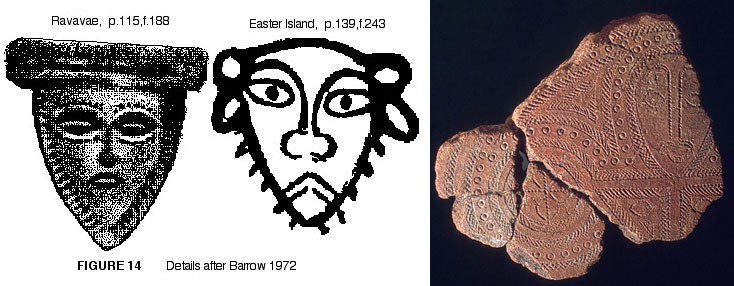
Lapita
pottery facial images are quite European. They show the pointed prominent chin
and small mouth clench, the leptorrhine [long, narrow] nose, facial hair (including
the moustache) or beards and thin lips. In the shard shown to the right the face,
incorporating European features, is housed within an Egyptian Ankh design. For
many millenniums prior to the epoch of the Lapita people and at the height of
Lapita civilsation, Egypt was ruled by Nordic European (physiology) Pharaohs.
The population of Egypt was still mostly European, but declining, as the years
wore on (see anthropological reports on pre-Dynastic and Dynastic mummies of Egypt
to about 1500 BC...several mummies of the Pharaoahs are on display at Cairo Museum).
After many centuries of stave-off warfare the Egyptians were finally overwhelmed
by the Nubians in about 800 B.C (the 24th and final dynasty of Egypt, with a Nubian
Pharaoh).
The circle dot markings seen on the Lapita
shards infer counts that, undoubtedly, relate to celestial cycle durations, calendar
counts or navigational numbers. This "knop" type marking was used from
ancient Israel to Ireland (see ancient Celtic crosses). The Lapita people were
very adept sailors and navigators and during their era, spanning about 1500-2000
years, ranged over a wide area of Melanesia and Polynesia. They also had domesticated
animals (pigs and dogs) or poultry and planted crops. They were largely responsible
for the introduction of the Polynesian Rat to many far-flung locations. The Polynesian
(Kiore) Rat has been in New Zealand for at least two milleniums. Perhaps the same
is true of the Norway Rat as well, the introduction of which is blamed on Captain
Cook. The native dog was, undoubtedly, introduced along with the Polynesian Rat,
two or more milleniums ago.
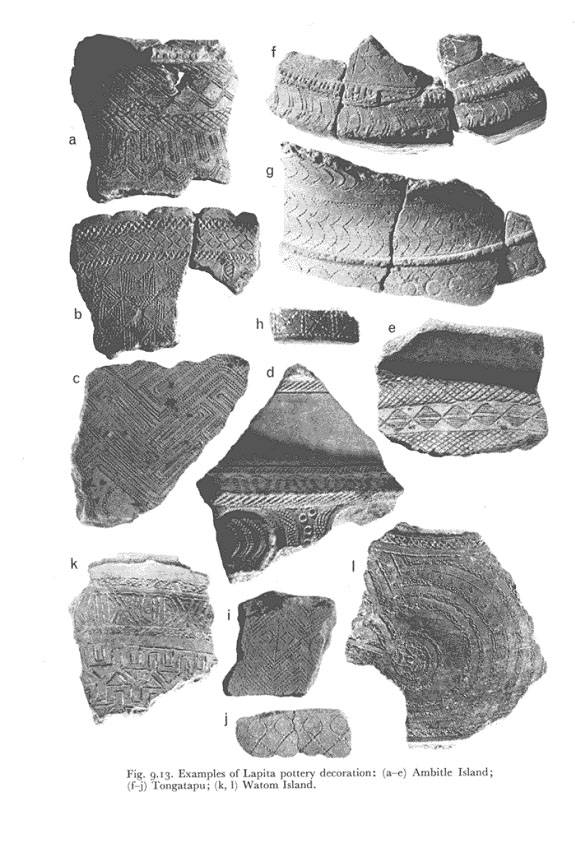
Shards
(a), (b) and (e) in the above sample clearly show the lozenge pattern that was
very prominently displayed on "Beaker People" pottery of Britain. The
Beaker people/ Wessex folk, who flourished in Britain from about 2500 BC erected
standing stone circles and barrow mounds, much the same as are found throughout
the Pacific, with its huge sampling of, mostly muted and played down, "stonework",
including many labouriously built, cut-stone, stepped pyramids. The Lapita People,
like the Beaker People, used bows and arrows and wove garments.
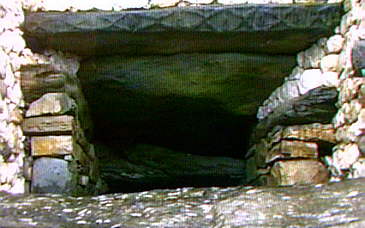
A
string of seven carved "lozenges" and two "part-lozenges"
is shown above the ancient "Winter Solstice window" opening at Newgrange
in Ireland, which dates to about 3000 BC. Both the "late" Beaker people
(Wessex folk) of England and the "early" Lapita people of the Pacific,
lived quite contemporary to each other and used the "lozenge" pattern
as their foremost cultural symbol.
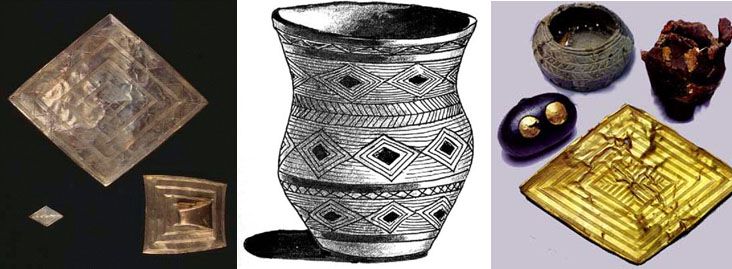
Lozenge
memory devices were very important to ancient astronomer/ priests and have been
excavated from their barrow mound graves in Southern England. The Bush Barrow
Lozenge device was located very close to Stonehenge and archaeologists theorise
that the individual with whom it was buried was somehow affiliated with the happenings
at Stonehenge. The Clandon Barrow Lozenge (left) is, similarly, mathematically
sophisticated and was found not too far Southwest of the Bush Barrow Lozenge.
To assess the circle and linear geometry by which the Beaker People (Wessex Culture)
or their forebears fabricated both lozenge memory devices, view: http://www.celticnz.co.nz/Clandonwebsitefiles/Clandon1a.htm
(six sections).
These lozenge devices carried cyclic
and navigational codes in their dimensions and angles, extractable by callipers,
a 360-degree compass and rule, they were used as memory and teaching aids or to
regulate all aspects of society, including quantity assaying in the marketplace.
They were very essential teaching tools for masters involved in schooling initiates
to the astronomical/ navigational arts. The never-to-be forgotten scientific parcel
of numbers that they incorporated assurred the continued maintenance of civilisation
and abundance.
Inasmuch as navigational codes were
built into the lozenges, they, like the Egyptian Hypocephalus funerary amulet,
were metamorphisised into symbolic or religious use as guidance devices for the
afterlife. The lozenge illustrated or incised burial beakers, found in Beaker
graves, inferred that correct navigation to the heavenly home had been spiritually
calculated and set. The god Ptah, depicted on the Egyptian Hypocephalus, serves
the same spiritual role to safely convey the newly dead to Orion, where Osirus
dwells. Just as the priestly lozenges had played such a primary role in the mundane
guidance of Beaker People society during mortality, so also did they in immortality.
Lozenge symbolism was thus adorned on the funerary beakers.
It
would appear that some of the Lapita pots are "grave goods", like the
Beaker pots. The lozenge design of the Lapita People became one of the most important
and venerated sacred symbols to be incorporated into Oceanic "tapa"
cloths.
Keri, you seem intense in your desire to stifle
any findings that might indicate an ancient Caucasoid or European presence in
Oceania (and New Zealand, especially) prior to the Maori. Any such heretical suggestions
you, rather vindictively, equate to "racism" and attempt to villify
and muffle by slander or gloved threats. You are the revisionist, not me.
You are the racist, not me. I have stayed with the reliable concepts of
40-years ago; it's you who has embraced the new plastic pseudo-history-religion,
not me.
You can, very conveniently, hide behind your new-age
fantasy-fictional writing and side-step the tangible facts that lie all around
you on your home landscape or within the oral traditions recorded by your forebears.
You pretend to be in touch with Maoritanga, but display all of the attributes
of a shallow, superficial new-ager, appologising for having European blood running
in your veins. But Europeans are people too and they, very definitely, went places
and did things all over the globe in remote antiquity...including setting up ancient,
long-term colonies in New Zealand and the greater Pacific. Maori culture is, largely,
European culture, with almost all symbols and artefact pedigrees traceable back
to Britain, Continental Europe and the Mediterranean Basin. Branches or influences
of Maori culture came via South America or other routes. Our "semi-flightless"
native Pukeko (swamp-hen) has long been a native of Spain, Portugal and South
America. Very old New Zealand Pohutakawa trees (600-years old) grow in La Coruna,
Spain and were the subject of a recent Spanish radio broadcast... then of course
there's the Egyptian-European-South American Hei-Tiki, etc., etc.
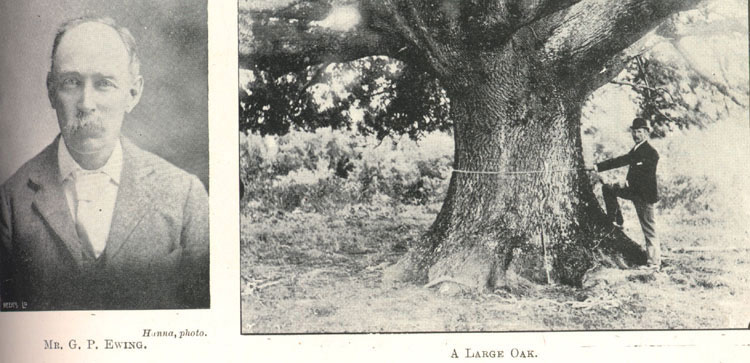
The
1902 edition of the Encyclopaedia of New Zealand (pg. 693) showed these
pictures of Mr. George Proudfoot Ewing, long-term resident and farmer at Whangarata,
38-miles south of Auckland City. Mr. Ewing had come to New Zealand from Scotland
in 1881. The picture to the right shows Mr. Ewing measuring, what is described
as,"a large Oak" tree at Whangarata or
in the nearby district. It would appear strongly that this tree is not a native
species of New Zealand, as the only native tree that we have described as an "Oak"
is the Alectryon excelsus (Titoki),
which is a medium sized tree that achieves a maximum height of only about 8-metres
(26-27 feet).
The girth of the tree shown is very substantial and it would
be impossible for a European Oak to have achieved such dimensions in the circa
100-year timeframe between the first trickle of European settlers arriving in
New Zealand and Mr. Ewing measuring the big girth tree.
The
Tuakau-Whangarata-Drury area was not developed into farms until around 1850 or
later, so where did this large species "Oak" tree come from? In comparison
to European Oaks of similar girth (approximately 5.5 feet, wide in the picture
when scaled) this tree should have been between 200-300 years old by the year
1900, which means it would have taken root as early as 1600 to 1700 AD. Perhaps
the rich volcanic soils of that South Auckland region and the mild winters might
have accelerated its growth somewhat, but even under the best case scenario this
tree must have predated European colonisation of New Zealand by a century or two.
At Drury, South Auckland is the Runciman Oak,
which is supposed to have been propagated from an acorn from the famous Cowthorpe
Oak of England. Whatever became of Mr. Ewing's venerable old Oak tree?
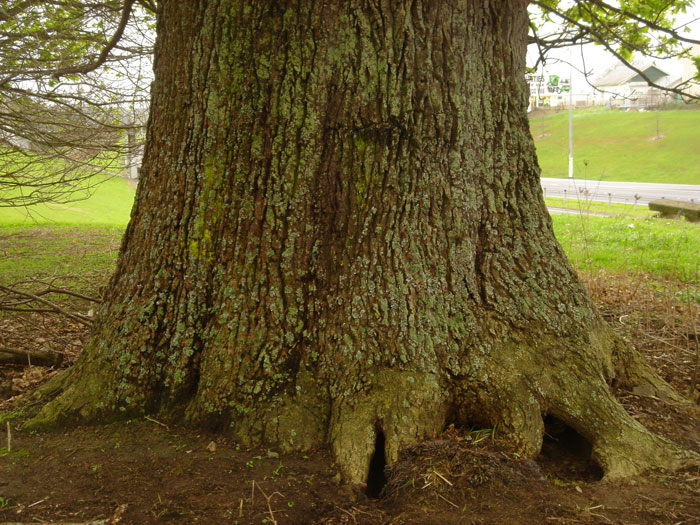
The
Runciman Oak of Drury, which sits on land that was once a part of the Runciman
farm of 2000 acres. Pictured on the left is Captain James Runciman, who was a
member of Colonel Nixon's Light Horse Cavalry throughout the Waikato Wars and
commander of the Cambridge troop. The Runciman Oak tree trunk (shown on the right)
has a diameter of 2 metres at half a meter above ground level. It's overall circumference
(somewhat oval shaped) is about 4.7 to 5 metres (about 16.4 feet). The tree has
been slowly dying since the motorway was put in beside it in around 1966. Sadly,
the north-eastern side of the tree is now quite rotten and has lost substantial
surface wood. Most of the large boughs have been lopped off in an attempt to save
the tree.
"Officially", this Oak is reported
to be only around 130-years old and grown from an acorn taken from the Cowthorpe
Oak of England (brought to New Zealand by the Runciman's?).

An
ancient form or development of the Hei-Tiki from Syria. There appears to be a
link between this figurine and the owl-eye circle geometry that was used to create
the Bush Barrow and Clandon Barrow Lozenges of the Beaker People of England. See
the design geometry at: http://www.celticnz.co.nz/Clandonwebsitefiles/Clandon1a.htm
Because
the, now extinct, ancient European Patu-pai-arehe of New Zealand or Children of
Poutini (the offspring of Tangaroa) throughout Oceania can no longer speak for
themselves, I will, unashamedly, speak for them and applaud their great works...
despite the fact it's not considered PC or in-vogue within the designer-engineered,
social climate that you've been duped into embracing.
Best
wishes
Martin.
From:
duane brooking
<matakae@hotmail.com>
Sent: Sunday, 11 July
2004 11:40 a.m.
Subject: Does the term Neo-imperialism mean? CEASE
AND DESIST THIS IS A WARNING
BE CAREFUL PAKEHA:
You seek to destroy
our culture and replace it with your lies masquerading as the the truth. This
is how it all got started in a place we used to call Yugoslavia, remember that?
I've had enough and I'm not taking anymore of this abuse!
UNDERSTAND YOUR
ARE ON THIN ICE:
How wrong is it when the oppressor uses the oppressed
to further their lust for mammon?
TAKE YOUR LIES OFF THE INTERNET OR SUFFER
THE CONSEQUENCES.
Try to understand the following to find out where this
message is comming from, if you havent deleted it already!
Ko te iro
ma!, Whakarongo! ki te koorero tika! Tukua mai ki ahau, Ko taku tupuna ko Tahu
Potiki a aitia, Atu ko Ira a Tahu, Takiritia e Rakatehurumanu. Aitia atu ko Nukuroa
ko Tahumari mahana Rakawahakura, Ko Rakaiwhakaata koia Tuhaitara. Ka moe ia Marukore
koia Tamaraeroa, Ko Te Aohikuraki, no te ai hataretaretanga kia Rakaitekura! Koia
te Hikutawatawa o Te Raki, to Ariki Tapu i Ngai Tahu e!
Which really
means to the ignorant like you, "I prevail over my enemies, by the incantations
which my ancestors and my father have handed down to me."
YOU THINK YOU
HAVE THE BATTLE WON, I SAY FORGIVE HIM LORD HE KNOWS NOT WHAT HE'S DONE!
That
is the only thing that will save you from your ignorance. You and Barry Brailsford
are cut from the same whitey cloth that just cant accept that dirty savage niggers
got here way before Pakeha, or any other culture for that matter.
HOW I
HEAR YOU WHINGE? BECAUSE I AM WAITAHA YOU AND BARRY ARE FRAUDSTERS PEDDLING LIES!!!!
SO STOP IT NOW!
(Duane then attaches a lengthy
tirade written by Mikare Harawira, one of his role-models, laced-full of all the
usual "grievance industry" Marxist jargon...I wonder if this is the
same Harawira that beat the living crap out of a friend of mine on her first day
of school over at Whenuapai?).
Duane,
I had some reservations about posting your "maketu-Christian" email,
as it's full of confusion. Nevertheless, I'll give you the benefit of the doubt,
put your threats into the Feedback section and respond.
At
this point in time, I'm not interested in limiting my research to the very late
New Zealand era of "Maori history"... especially, the "grievance
industry" version that you've embraced. I devote my time to studying pre-Maori
history, based upon the very real and tangible structures that lie all over
our New Zealand landscape. In the course of this study, I sometimes work with
open-minded and progressive Maori elders and kuias, who provide me with good leads
and insights about how our history unravelled. One of my research colleagues,
who devotes her time moreso to "real" colonial history is Ngai-Tahu
kuia, Jean Jackson. She writes:
"Professor
Barry Fell was trained by my Grandmother, Elizabeth Hislop, in Maori Anthropology
and he acknowledged my Mother's contributions long before she became the oldest
Ngai Tahu for a while. She [Helen Stuart] died at 100½ in 2003."
Jean
is righteously indignant about her Ngai Tahu tribe's falsification of New Zealand's
colonial history and does all in her power to set the record straight, based upon
indisputable, documented evidence. She and her mother have gone head-to-head with
Tipene O'Reagan on this issue. She's now into about her sixth book on how our
true documented history has been glossed over and falsified in order to leave
New Zealanders wide open to grievance industry plunder. It'll come as a great
surprise to you Duane, but not all Maori share your mindset about distorting colonial
history to "turn a buck" or "censoring the more ancient,
pre-Maori, New Zealand history". In fact, many oppose all such agendas
vehemently. Foremost amongst those calling for full exposure are many Waitaha,
from whom you claim descent.
Your racist jibes
are ridiculous and disgusting. Don't put such words into my mouth, as this is
solely your vomit, not mine!
As for me, "seeking
to destroy your culture", as you put it, this is a lie. I will, however,
continue to identify all symbols or cultural expressions that you inherited by
conquest, which were formerly ours and were used by my European ancestors regionally
or abroad for millennia's. Many things in your possession were derived directly
from our Patu-paiarehe cousins and were carried by them from the Mediterranean
or Europe, long before the Maori era.
Waitaha were conquered by Ngai Tahu and now there are at least three groups within
Waitaha with differing points of view concerning how to chart the future. There
are corporate-kaumatua trainees like yourself, who are fully in the Ngai Tahu
camp and paying only token lip service to the very ancient oral traditions of
Waitaha. There are those who don't know where their allegiances lie, whether it
be toward the Ngai Tahu conquerors and their modern money grubbing agendas or
to the older, pure traditions of Waitaha. Then there are those elders who want
the very ancient histories of Waitaha to be made public. These are the same individuals
who approached Barry Brailsford and asked him to record many hundreds of
the old songs of Waitaha and place them into the public arena, such that they
could be shared by all the world.
One of the large delegation of
Waitaha and related, benevolent elders or kuias who participated in gathering
together the "Songs" was Dame Whina Cooper, who wrote
the following in the book, Song of Waitaha:
Panguru, Hokianga,
Nth Auckland.
Te Mana! Te Ihi! Te Wehi! Te Tapu!
Kai
Koutu e nga Iwi, Ki Oku Whanaunga i Aotearoa nei, Tena Koutu, Tena Koutu, Tena
Koutu.
It is my prayer to my God above that we all learn to live
as one people in Aotearoa. This Taonga that I have been involved with has kept
us all very busy. I have travelled from Panguru to Wellington to Awhi, my Whanau
who have worked on this very Tapu journey throughout the Country, doing the work
that was set for them by my whanaunga in Te Waipounamu.
They have
kept the tapu, the ihi and the wehi of the kaupapa and have finally finished the
work, Kai ora koutou katoa. Me Awhi Koutou, i Kaupapa tuturu o nga matua tupuna,
Kai manaaki e tatau ia tatou, Kai ora ai tatou katoa i roto i Te rangimarie.
You
must all look after the teachings nga tohutohu, of your parents and grandparents,
that is we must look after one another so that we might live in peace. That is
my prayer and my wish for us, that we will learn to live together, the Maori and
the Pakeha, living together as one nation.
Herea te tangata ki te
whenua, bind the people to the land. Ki ora mai ano tatou. Ma te Atua tatou e
manaaki e tia ki mo ake tonu atu.
Dame Whina Cooper, M.B.E., C.B.E.,
O.N.Z., J.P. Mother of the Nation of Aoteroa. Dame Of The British Commonwealth
Of Nations.
Perhaps, instead of ignorantly railing against Barry Brailsford
and, by consequence, your own learned elders, you should read the Introduction
to the book, written by a kaumatua...a beautiful piece of text, which fully sets
the stage and identifies the reason why the learned elders wished these
truths to be made public.
You do Barry Brailsford
a grave injustice with your uninformed slander, as he is a very gentle and accommodating
scholar. He did not ask for the assignment of recording the 2000 Songs of Waitaha,
of which only about 200 have, so far, been made available for posterity. It was
an assignment that was laid on him by Waitaha elders. His goodwill and
willingness to help has taxed his strength greatly and has, oftimes, had a tiresome,
detrimental effect on his composure, health and resources. Perhaps he should have
taken the easy road in his professional life, of only regurgitating the "politically-approved",
grievance industry pseudo-history rubbish. That way he could have had a very cushy
and comfortable existence, basking in the honours accorded by his, earlier awarded,
M.B.E., and, remaining aloof from the ill conceived curses and threats that spew
forth from Marxist-indoctrinated, grievance industry spawn like you.
Do
you realise that Barry Brailsford did not make so much as a "brass razoo"
out of publishing "Song of Waitaha"? All rights to the
content of that inspired work are claimed by Waitaha-Maori factions, who take
unto themselves all monies related to the sale of the book. As far as I know,
Barry was left to pay all or most of the production debts by himself and remains
about $50,000 in the hole, although the book is an international "best seller".
This
elusive "mammon" that your refer to, in very Bible-speak
terminology, is certainly never seen by any of the honest researchers subsisting
at this level of the food-chain. It's quite apparent that there's no money, whatsoever,
to be gained in telling the truth. Most of us have to take a vow of poverty
and carry on as best we can, virtually "robbing Peter to pay Paul".
I can say in all honesty that I know of no researchers in this country (other
than "in the pocket" grievance industry historians/ archaeologists)
who can do more than "break-even" in their quest to preserve,
at least, some of the precious truths related to our past.
If,
as you intimate, it is your "behind the scenes" desire to conjure up
maketu against me by incantations, then I say to you:
I
do not accept your curse, as I have not earned it and am undeserving of it. I
work with honesty and integrity to find the true history of this land. I, therefore,
return your curse to you, unfulfilled, and yet in need of the vengeance for which
you conceived it. It is you, not I, who wishes to dabble with and conjure up evil
from some dark netherworld, and you must now deal with anything you have tried
to summons or unleash. No such evil was ever invoked by me, nor shall any abide
with me for even an instance. As I will so mote it be.
As
I said to you, I study the structures and works of people known by you as Patu-paiarehe,
Turehu and many other regional Maori titles. In their earlier homelands, before
coming here about 3000-B.C. and later, they were the pre-Celts, or that amalgamation
of tribal groups that formed into the Celts by 1000 B.C. Your self-indulgent propaganda
does not allow you to acknowledge that we have deeply profound and developed spiritual
dimensions within our very ancient culture. The bullaun bowls found around this
country were once a part of our blessing and cursing altars.
My
gentle and overly accommodating European people have listened patiently to a lot
of nonsense, endless whinging or have been subjected to far too much school-yard-bully,
control-freak-type demands during the past thirty years. We are expected to cast
aside, as dross, excellent scholarship and precious truths, handed down by reliable
old historians and wharewaanaga elders, then embrace your new, self-agrandizing
and self-enriching pseudo-history. Your "separatist" ilk attempts to
write Europeans out of the Treaty
of Waitangi and make us second class citizens or slaves, subservient to
you. It might pay you to read the words of the Paramount Chiefs, who met together
at the Kohimarama Conference in July, 1860 to advise and share their views with
the New Zealand Governor, Gore Browne about The Treaty (see Investigate
Magazine, August 2004 issue). He Iwi Tahi Tatou!
For
thirty years your Marxist-inspired activists and money-grubbing corporate kaumatuas,
working in closely with "big-business", have snapped at our heels like
annoying scavenger-dogs, wounding us and insulting our culture, so as to be left
free to plunder "all the people of New Zealand", altogether.
...'but I fear, all you have done is awakened
a sleeping giant with a terrible resolve'.
Martin.
From:
Faleafa Toetau
Date: Friday, 30 July
2004 11:59 p.m.
Subject: Response to
site.
I am a Samoan who has and always will be interested in
world history, especially ancient history. I would like to congratulate you on
moving away from established views on New Zealand history, to investigate evidence,
which I agree cannot be ignored. After all I believe that mankind is much more
ancient than we can possibly fathom. It is possible that cultures, which were
separated in recent history, could have cross paths with one another in ancient
times.
As a Polynesian, I could understand the Maori view and why they
might disagree, but I've noticed that the 'moko' (facial tatoo) design is strikingly
similar to Celtic design, and the way that they built their 'marae', is also similar
to how Celtic houses looked, but almost nothing like Polynesian houses.
The
fact that the sweet potato came from America is well known, but what isn't is
that the name of never changed. The Indians called it 'cumera', the Polynesians
called it 'kumala' or 'kumara' in Maori.
To the owners of
this site I say good on you and keep it up. I doubt its possible to know everything
about the past, but think the truth for better or worse is always the best way
to go.
Hi Faleafa,
Many thanks for your encouragement to keep
searching.
Samoan friends have told me that the Island of Savaii
in the Samoan group is considered to be the birthplace of eight Pacific nations,
including the New Zealand Maori. My friends tell me that the mystical homeland
of "Hawaiki", from whence the Polynesian Maori claim to have
come, is actually "Savaii". Were the Maori pronunciations able
to revert back to the original language sounds of many generations ago, I'm told,
"Hawaiki" would become "Savaii".
I am
very interested in the design and structural content of the Pulemelei Mound on
Savaii and to learn that it is a stone walled structure overlaying a carved earthen
mound. It is said to have a souterrain tunnel system within it, which is now mostly
blocked off and inaccessible, but yet breezes are emitted from within the structure
through small holes and fissures. This seems to indicate that larger openings
still exist in the region, sufficient for the prevailing winds to pressurise the
internal tunnels of the mound.
In many respects, the Pulemelei mound is
very much like our stone PAs of New Zealand, where hillocks are carved with steep
walls and, sometimes overlaid by stone. One very good surviving example of this
kind of stone construction is Koru PA of Taranaki, with its souterrain tunnel
system and very sophisticated "standing stone circle" sitting at the
side of it.
What I find most intriguing about the Pulemelei Mound is the
reports of many "cairn" marker structures scattered around the mound
and further cairns and markers atop the mound platform. This clearly indicates,
to me, that at Pulemelei there is a surveying and land-mapping function in the
layout of structures and that you have, there, the same type of land marker coding
as occurs in special locations here in New Zealand.
I have been told that
an archaeological team from the Thor Heyerdahl Museum has been identifying then
logging positions of stone markers on and around the mound structure. I feel very
confident that, if satellite navigational fixes could be taken on all the purpose
placed marker positions there, and the dimensions of the mound accurately measured,
then the standard mathematical parcel of coded navigational and cyclic numbers,
found encoded into landscapes from Egypt to Oceania, would be revealed at Pulemelei.
My
friends tell me that clues related to this special ancient knowledge can still
be found in the higher Matai and Royal languages of Samoa. It would seem that
parts of the knowledge have been preserved and passed down, but that these (now
fragmented?) principles are known only to an elite few. You'll find, however,
that the complete knowledge still sleeps in the positions of those cairns and
in the angles or distances related to where the cairns sit away from the resolving
positions on the mound plateau. My guess is that the mound itself will have been
placed in that exact position to relate to outlying natural geological features
in the distance...even perhaps an outlying Island...and how that outlying position
relates to an observable solstice or equinox sunrise or sunset. It'll be something
along those lines.

This
image was digitally photographed from a rare book about the life of missionary,
John Williams, who arrived in the Samoan group in 1831 with 8 Tahitian missionaries.
The caption on the above picture read: One of the maraes, vast stone
platforms used for ancient Polynesian rites.
It's really
a pity that our modern regional historians will not deal with these many Pacific
structures, which are so similar to what one finds in South America... or across
the Atlantic in the Canary Islands... then further east to Egypt and Persia, etc.
Our establishment historians and archaeologists are so intent in trying to "prop
up" their very incomplete, exclusive and mostly unsustainable, isolationist
hypotheses that it becomes taboo for them to mention the impressive works of the
very ancient "Stonebuilders", who once ranged throughout Oceania.
Concerning
New Zealand, you are in agreement with Thor Heyerdahl, who wrote:
'Irrespective
of how and when the Maori began to cover their carvings with spirals, the habit
is absent in their Polynesian homeland and may therefore very well be so in their
still earlier fatherland further away. There is, indeed, no such curvilinear surface
design on the wood carvings of the Society Islands and these include the very
tall ancestral posts which were erected in ancient Tahiti' (see American Indians
in the Pacific, pg. 116).
Somewhere around here I've
got a picture of a South American Indian with a very Maori looking moko on his
face. I'll seek it out and put it with this letter later.
Best
wishes, Martin.

